Australia Diabetes Drugs and Devices Market Size
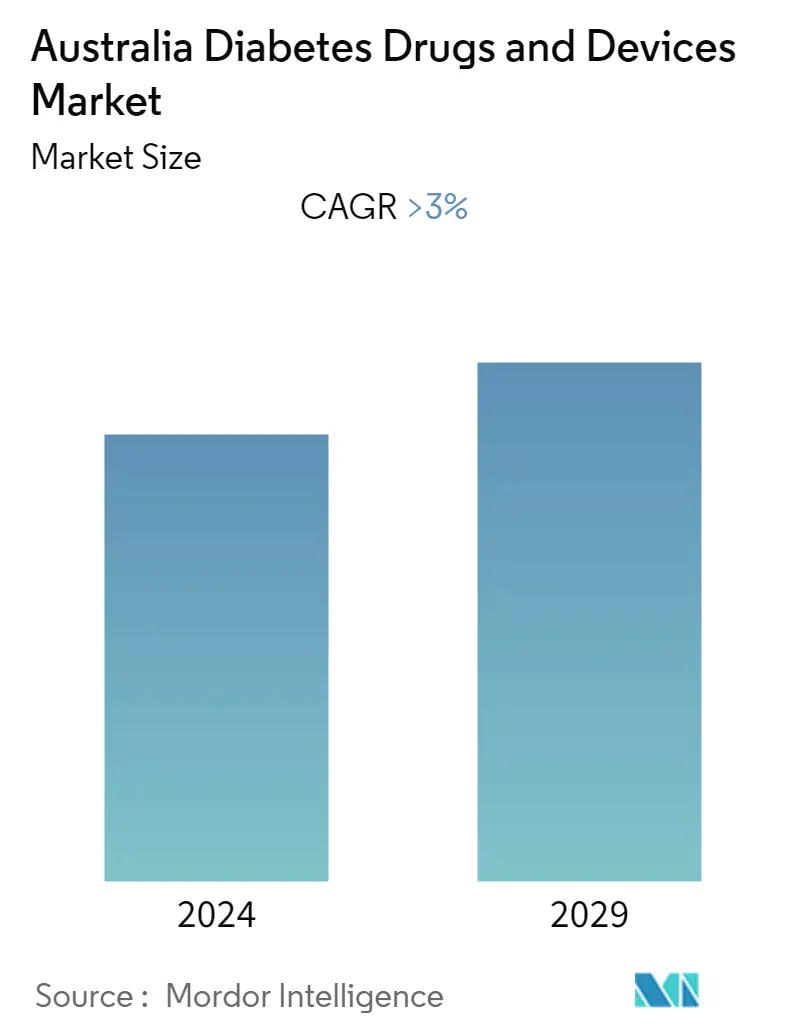
| Study Period | 2018 - 2029 |
| Base Year For Estimation | 2023 |
| Forecast Data Period | 2024 - 2029 |
| Historical Data Period | 2018 - 2022 |
| CAGR | > 3.00 % |
Major Players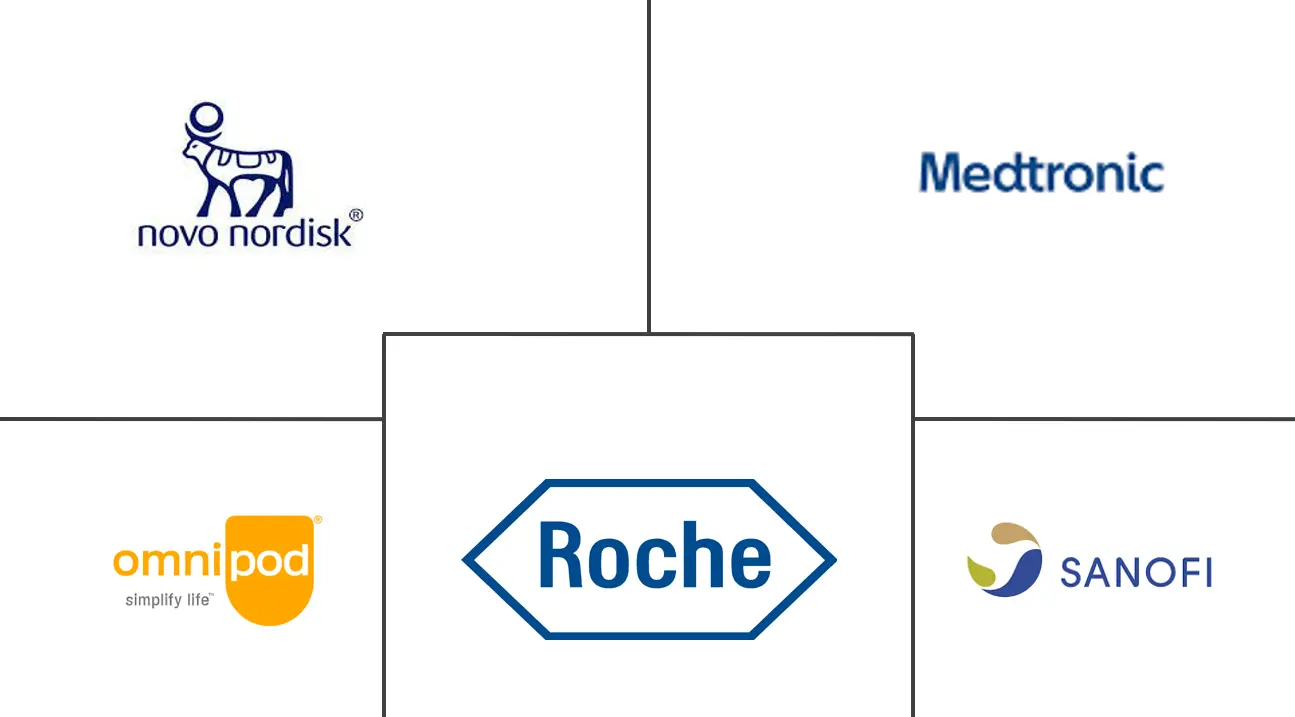
*Disclaimer: Major Players sorted in no particular order |
Australia Diabetes Drugs and Devices Market Analysis
The Australian diabetes drugs and devices market size is estimated at USD 1.4 billion in the current year. The market is expected to reach USD 1.7 billion in five years, registering a CAGR of more than 3% during the forecast period.
The COVID-19 outbreak has accelerated the expansion of the Australian diabetes drug market. People with diabetes infected with COVID-19 can develop high blood sugar levels, irregular blood sugar fluctuations, and diabetic complications. There have been 9,235,681 confirmed COVID-19 cases in Australia since the pandemic began in July 2022, according to the Australian government's Department of Health and Aged Care. The prevalence of diabetes in adults with COVID-19 may be higher than that of patients with type 1 (T1DM) or type 2 (T2DM) diabetes, especially when glycemic control is poor. They are leading to a significant increase in the severity and mortality of cancer. On the other hand, emerging hyperglycemia and diabetes (both T1DM and T2DM) associated with COVID-19 are increasingly recognised and associated with poor prognosis. Patients' blood glucose levels should be checked and maintained regularly to minimize exacerbations, highlighting the importance of drug therapy in diabetes treatment.
Obesity, poor diet, and lack of exercise contribute to the increasing number of newly diagnosed cases of type 1 and 2 diabetes. Rapid increases in the incidence and prevalence of diabetes and healthcare costs in developed countries indicate increased use of diabetes care products. In addition, the rising incidence of diabetes and increasing use of insulin-delivery devices are driving the expansion of the market. Leading manufacturers focus on technological advances and developing improved products to gain significant market share.
Thus, the above factors are expected to drive the market growth over the forecast period.
Australia Diabetes Drugs and Devices Market Trends
The continuous Glucose Monitoring Segment is Expected to Witness the Highest Growth Rate Over the Forecast Period
Continuous blood glucose monitoring is a popular alternative to commercially available portable finger glucose meters for people with diabetes. Continuous glucose monitoring sensors use glucose oxidase to measure blood sugar levels. Glucose oxidase converts glucose to hydrogen peroxidase, which reacts with platinum in the sensor to send an electrical signal to a transmitter. Various promising glucose sensor technologies are being developed, ranging from traditional electrochemical glucose sensors to new optical and other electrical glucose sensors, positively impacting the market growth.
The National Diabetes Services Scheme (NDSS) is an Australian government initiative. Once the patient is enrolled in their NDSS, they can use the blood glucose monitoring product with a subsidy. Registration with the NDSS is free and open to anyone in Australia who has a Medicare card and is diagnosed with diabetes. Patients and medical team members are required to complete an NDSS registration form. NDSS supplements blood glucose strips. Patients with type 1 diabetes are eligible for subsidized FGM and CGM. In addition, current continuous blood glucose monitors can display blood glucose trends by downloading data or providing real-time images of blood glucose levels through the receiver's display. In addition, current continuous blood glucose monitors can display blood glucose trends by downloading data or providing real-time images of blood glucose levels via the receiver's display. The emergence of new technologies, such as cell phone integration, will likely make continuous blood glucose monitoring devices cheaper, boosting the field. The emergence of new technologies, such as cell phone integration, will likely make continuous blood glucose monitoring devices more affordable, boosting the field.
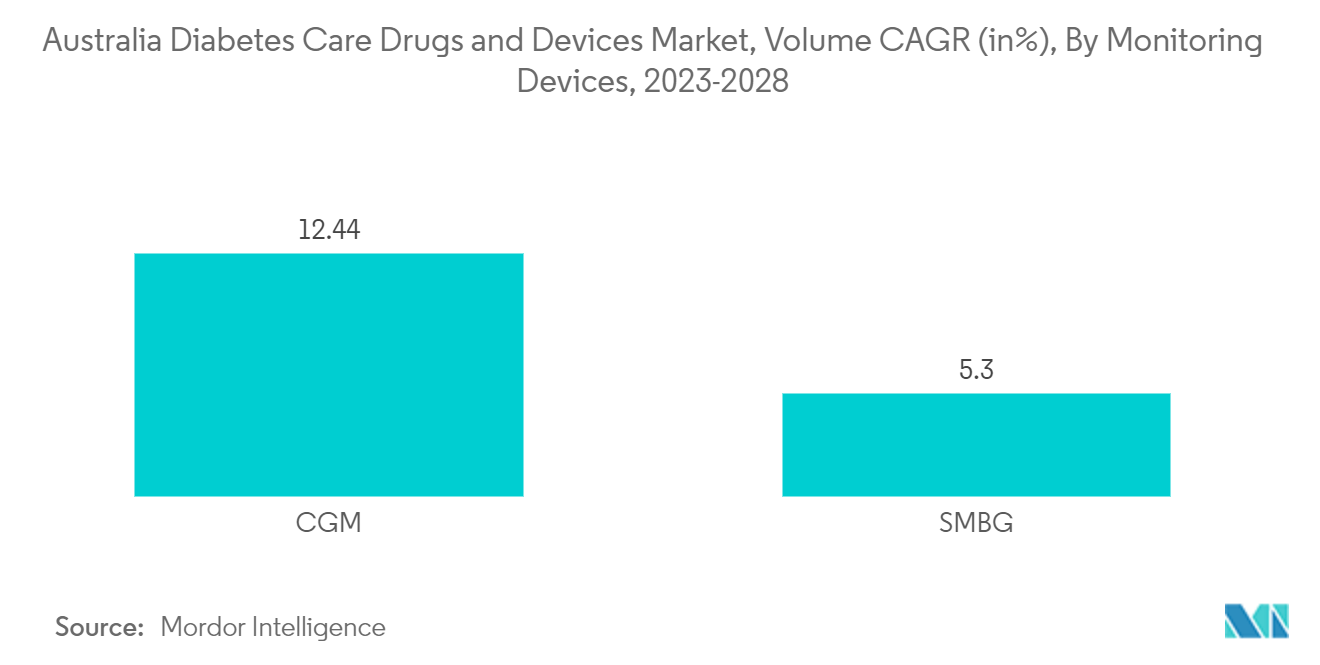
Rising diabetes prevalence
The diabetic population in Australia is expected to grow by approximately 2.5% during the forecast period. According to Diabetes Australia, diabetes is Australia's fastest-growing chronic disease, rising faster than other chronic diseases such as heart disease and cancer. Approximately 1.9 million Australians have diabetes, including all forms of diagnosed diabetes (about 1.5 million known and registered) and undiagnosed type 2 diabetes (up to 500,000 presumed to be human). The incidence of diabetes in children and adolescents is increasing. Nearly all children and adolescents with diabetes have type 1 diabetes. In addition, the child develops type 2 diabetes when he is young. Children and adolescents with type 1 and type 2 diabetes have unique needs, including care from a multidisciplinary childhood diabetes team, diabetes care, and access to assistive technology.
One of the main goals of diabetes treatment is to maintain blood sugar levels within specific target ranges. This can be achieved through activity, lifestyle, and a balanced diet with diabetes medications. Blood glucose monitoring readings provide the information to determine the optimal diabetes management strategy. Keeping your blood sugar within your target range can reduce your risk of developing diabetes-related complications such as diabetic retinopathy, heart disease, and kidney disease. How often people with diabetes check their blood sugar levels depends on how often they use insulin due to several factors. People with type 2 diabetes who don't use insulin may not need to check their blood sugar regularly. However, systematic self-monitoring for a period may be helpful.
Adolescents are at a higher risk of developing diabetes at an early age due to their younger age and longer duration of diabetes, which reduces the quality of life, shortens life expectancy, and increases social health expenditure. As a result, the demand for antidiabetic drugs and their approval rates are rising, which drives the market. Furthermore, with the growing awareness of people with type 2 diabetes, the need for diabetes drugs and devices is rapidly increasing.
The increasing diabetes prevalence and the above factors will likely drive segment growth over the forecast period.
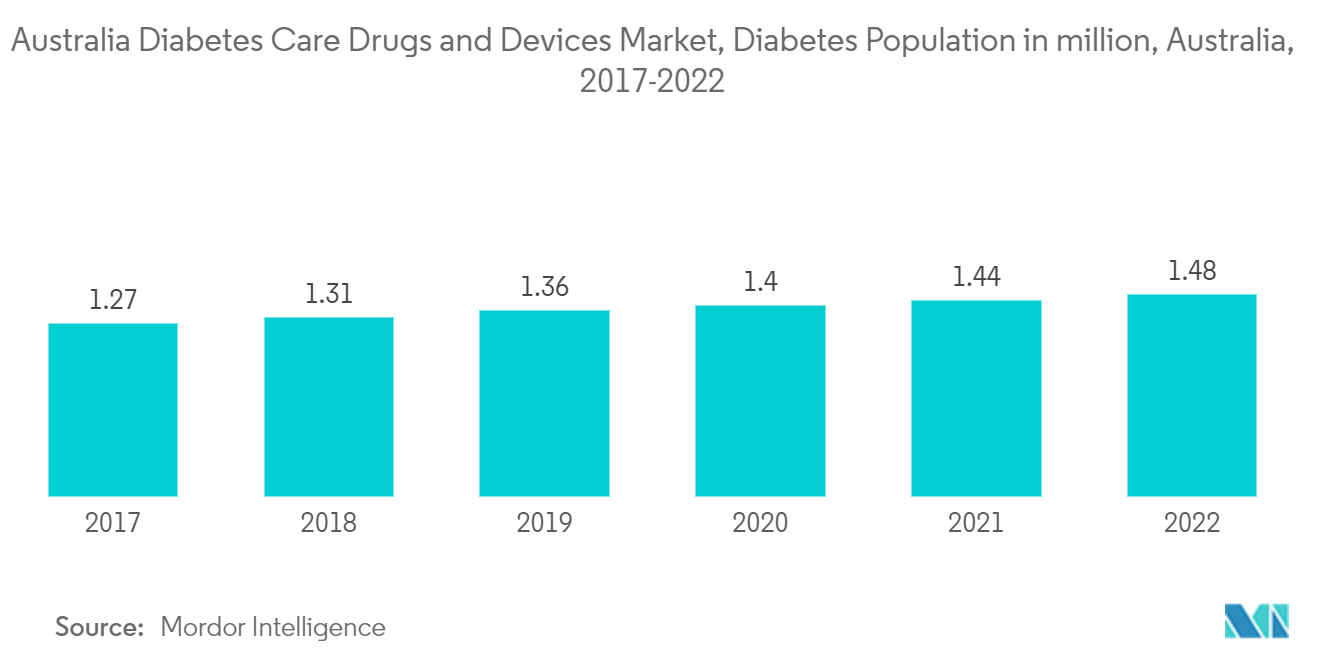
Australia Diabetes Drugs and Devices Industry Overview
Manufacturers have constantly innovated to survive in the market. Large companies such as Abbott and Medtronic have made numerous mergers, acquisitions, and partnerships to gain market dominance while adhering to organic growth strategies. The manufacturers of insulin delivery devices are spending a huge amount on the R&D of the devices. For example, Novo Nordisk partnered with Abbott Diabetes Care, which may also assist in enabling insulin statistics to be shared between Novo Nordisk-connected insulin pens and digital fitness equipment well suited to the FreeStyle Libre portfolio of products. Mega Blockbuster Lantus, manufactured with the aid of Sanofi, led the basal insulin field.
Australia Diabetes Drugs and Devices Market Leaders
-
Medtronics
-
Roche
-
NovoNordisk
-
Sanofi
-
Omnipod
*Disclaimer: Major Players sorted in no particular order
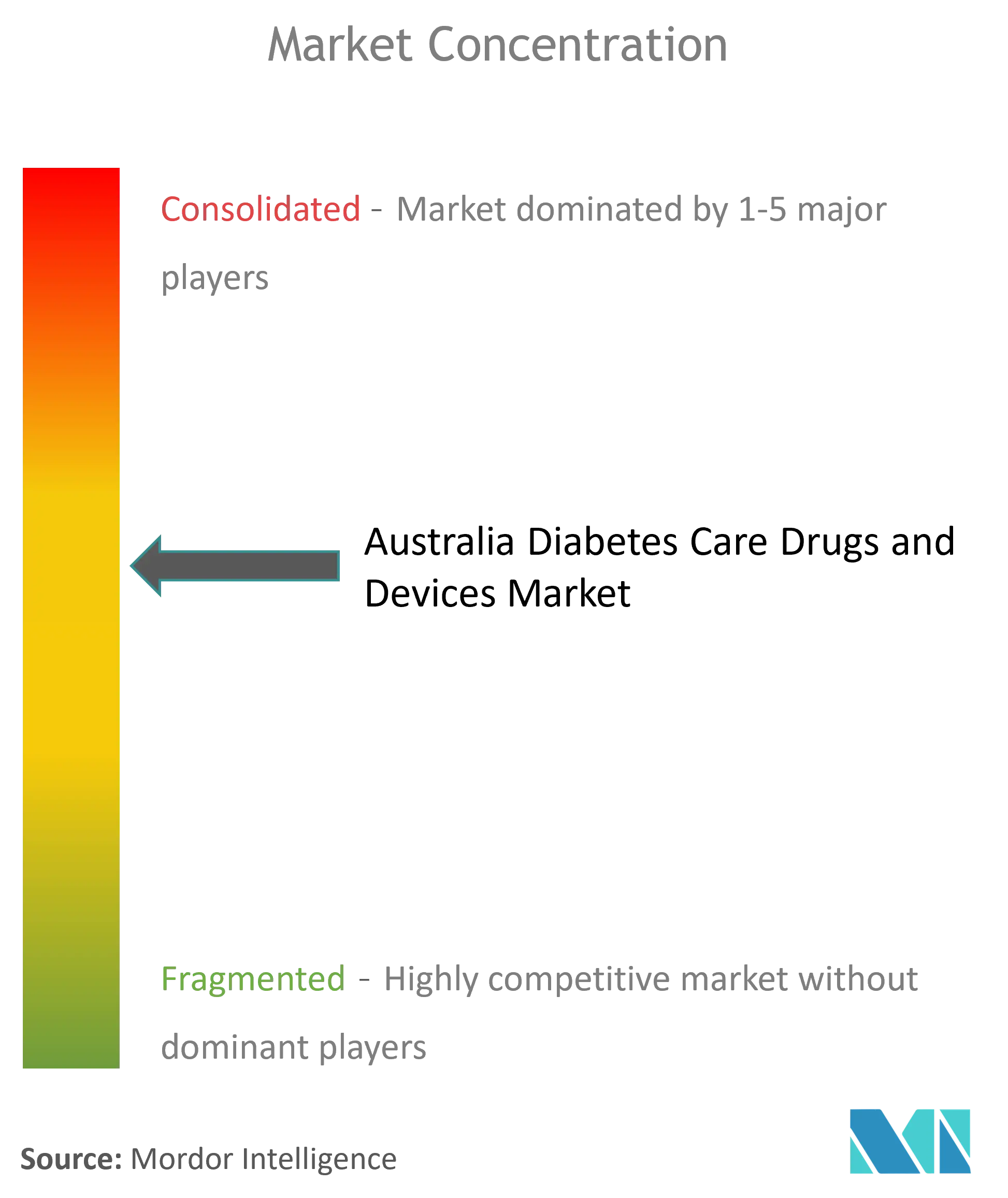
Australia Diabetes Drugs and Devices Market News
- March 2023: The Albanese Government extended access to Fiasp insulin and Fiasp FlexTouch via the Pharmaceutical Benefits Scheme for six months. Under the arrangements, people with a current prescription for Fiasp can access it for the next six months.
- November 2022: Eli Lilly and Company announced that it would roll out its first connected platform, the Tempo Personalized Diabetes Management Platform. The technology aims to help adults with type 1 or 2 diabetes and clinicians make informed, data-backed decisions to manage treatment with Lilly insulins. The platform consists of three key components - the Tempo Smart Button, a compatible app, and a prefilled insulin pen, Tempo Pen. They work together to deliver personalized guidance for adults with diabetes.
Table of Contents
1. INTRODUCTION
1.1 Study Assumptions and Market Definition
1.2 Scope of the Study
2. RESEARCH METHODOLOGY
3. EXECUTIVE SUMMARY
4. MARKET DYNAMICS
4.1 Market Overview
4.2 Market Dynamics
4.2.1 Market Drivers
4.2.2 Market Restraints
4.3 Porter's Five Forces Analysis
4.3.1 Bargaining Power of Suppliers
4.3.2 Bargaining Power of Consumers
4.3.3 Threat of New Entrants
4.3.4 Threat of Substitute Products and Services
4.3.5 Intensity of Competitive Rivalry
5. Market Segmentation (Market Size by Value - USD)
5.1 Devices
5.1.1 Monitoring Devices
5.1.1.1 Self-monitoring Blood Glucose Devices
5.1.1.2 Continuous Blood Glucose Monitoring
5.1.2 Management Devices
5.1.2.1 Insulin Pump
5.1.2.2 Insulin Syringes
5.1.2.3 Insulin Cartridges
5.1.2.4 Disposable Pens
5.2 Drugs
5.2.1 Oral Anti-Diabetes Drugs
5.2.2 Insulin Drugs
5.2.3 Combination Drugs
5.2.4 Non-Insulin Injectable Drugs
6. Market Indicators
6.1 Type-1 Diabetes Population
6.2 Type-2 Diabetes Population
7. COMPETITIVE LANDSCAPE
7.1 Company Profiles
7.1.1 Novo Nordisk
7.1.2 Medtronic
7.1.3 Insulet
7.1.4 Tandem
7.1.5 Ypsomed
7.1.6 Novartis
7.1.7 Sanofi
7.1.8 Eli Lilly
7.1.9 Abbottt
7.1.10 Roche
7.1.11 Astrazeneca
7.1.12 Dexcom
7.1.13 Pfizer
- *List Not Exhaustive
7.2 Company Share Analysis
8. MARKET OPPORTUNITIES AND FUTURE TRENDS
Australia Diabetes Drugs and Devices Industry Segmentation
Patients with type 1 diabetes must be given insulin because their pancreas cannot process it. To control blood sugar levels, insulin must be given several times daily, such as when eating or drinking. Many people with type 2 diabetes also need to take antidiabetic drugs. These drugs include diabetes medications and injections, such as insulin. The Australia diabetes drugs and devices market is segmented by drugs (insulin, oral anti-diabetic drugs, non-insulin injectable drugs, and combination drugs), and devices (management devices such as insulin pumps, insulin pens, syringes, cartridges, and jet injectors, and monitoring devices including self-monitoring blood and continuous glucose monitoring). The report offers the value (in USD) and volume (in unit) for the above segments.
| Devices | ||||||
| ||||||
|
| Drugs | |
| Oral Anti-Diabetes Drugs | |
| Insulin Drugs | |
| Combination Drugs | |
| Non-Insulin Injectable Drugs |
Frequently Asked Questions
What is the current Australia Diabetes Drugs and Devices Market size?
The Australia Diabetes Drugs and Devices Market is projected to register a CAGR of greater than 3% during the forecast period (2024-2029)
Who are the key players in Australia Diabetes Drugs and Devices Market?
Medtronics, Roche, NovoNordisk, Sanofi and Omnipod are the major companies operating in the Australia Diabetes Drugs and Devices Market.
What years does this Australia Diabetes Drugs and Devices Market cover?
The report covers the Australia Diabetes Drugs and Devices Market historical market size for years: 2018, 2019, 2020, 2021, 2022 and 2023. The report also forecasts the Australia Diabetes Drugs and Devices Market size for years: 2024, 2025, 2026, 2027, 2028 and 2029.
Australia Diabetes Drugs and Devices Industry Report
Statistics for the 2024 Australia Diabetes Drugs and Devices market share, size and revenue growth rate, created by Mordor Intelligence™ Industry Reports. Australia Diabetes Drugs and Devices analysis includes a market forecast outlook to for 2024 to 2029 and historical overview. Get a sample of this industry analysis as a free report PDF download.



